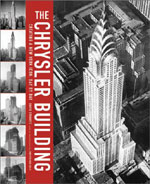"The Jewel In The Crown Of New York City's Skyline" | |

| It's interesting how different places affect different people. On my last visit to New York I took along a friend making his first visit. We both enjoyed the usual jazz/improv gigs, the strange & wonderful stock in St Marks Bookshop [and the fact it opened till late] and ambling through the areas that are only just about starting to be gentrified. But my friend became obsessed with the Chrysler Building, something I've only ever done little more than admire glinting in the sunshine, an art deco oddity among the more minimal skyscraper horizon. The Chrysler Building: Creating a New York Icon Day by Day, a beautiful hardback photographic book from Princeton Architectural Press does little to change my mind. The book reproduces a fortuitous "find" of some old plate negatives from the 1920s, showing the construction of the skyscraper. To be honest though, the more "architectural" photos are pretty dull [perhaps architects won't think so], showing a never-ending Meccano-like assembly of iron girders slowly being clad with whatever skyscrapers were clad with. No, of far more interest are the shots of the interior, and ones that contextualise the building within New York City. For me at least, New York is exciting because of what goes on there - music, literature, art, and the people who live there or visit. So it is the photos where people enter the scene that excite: people viewing the foundations being dug, cars and van drivers chatting in the street, passers by oblivious to the Chrysler's presence, engineers in their office, builders dwarfed by the massive art deco birds they are assembling as they stand on them - the same birds that look so small from below, today. So whilst it's interesting seeing the slow ascent of a skyscraper, and seeing the empty offices inside the Chrysler - unexpectedly decorative and "flash" in this case - its the wider picture that intrigues. It's the old elevated subway lines, people's clothes, the advertising signs, old trucks, and the panoramic views of the city - photographed both at night and during the day. Buildings only work in context it seems to me, when in use. [Think about the problems that occur when minimalist tower blocks were built in the 1960s; the ghetto estates that were the result.] This book works because it isn't totally obsessed with its subject, it's just used it as a focus to the photographic collection. But I'm a little at a loss to know who will buy it? It may not be technical enough for the architecture world, nor general enough for the New York enthusiast. The press release talks about "the thrill of the machine age" but the book seems to bypass this thrill totally; the only machines are the odd crane and some cars & trucks. Certainly, I will still rather turn to my jumble sale copy of Look at America: New York City, published in 1948, if I want a feel for the vibrant, exciting city of New York in an earlier age. It is New York's warmth and excitement that is missing from this cool, if wonderfully printed and designed, new title. © 2002 Rupert Loydell |